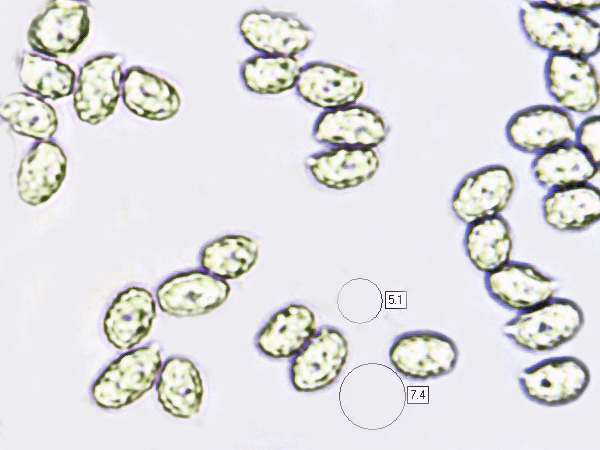Melanoleuca melaleuca (Pers.) Murrill
Phylum: Basidiomycota - Class: Agaricomycetes - Order: Agaricales - Family: Tricholomataceae
Distribution - Taxonomic History - Etymology - Identification - Culinary Notes - Reference Sources
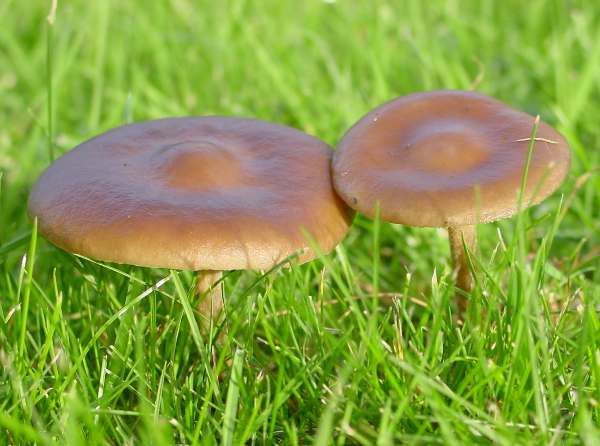
More often seen in grassland than the very similar Common Cavalier Melanoleuca polioleuca with which it is easily confused, this 'cavalier' mushroom has no generally-accepted common name even though it is commonly recorded.
It is difficult to separate this species from other brown-capped cavaliers, notably Melanoleuca polioleuca whose spores are more elongated spores and which has pointed, fusiform gill-edge cystidia (lacking entirely in M. melaleuca).
Distribution
Widespread and fairly common in Britain and Ireland, Melanoleuca melaleuca occurs throughout mainland Europe and is found also in North America.
Taxonomic history
This mushroom was described in 1801 by Christiaan Hendrik Persoon, who established its basionym when he gave it the binomial scientific name Agaricus melaleucus. (In the early days of fungal taxonomy, most of the gilled mushrooms were included initially in a huge genus Agaricus; later many new genera were erected into which the majority of species were transferred, so that nowadays the genus Agaricus is rather more manageable!)
It was American mycologist William Alphonso Murrill (1869 - 1957) who in 1911 transferred this species to its present genus, thereby establishing its currently-accepted scientific name Melanoleuca melaleuca.
Synonyms of Melanoleuca melaleuca include Agaricus melaleucus Pers., Tricholoma melaleucum (Pers.) P. Kumm., Melanoleuca graminicola, Melanoleuca vulgaris, and Melanoleuca melaleuca var. melaleuca (Pers.) Murrill.
Melanoleuca melaleuca is the type species of the genus Melanoleuca, a very difficult group of about 50 species that even professional mycologists struggle with.
Etymology
The genus name Melanoleuca comes from the Ancient Greek words melas meaning black, and leucos meaning white. No cavalier mushroom is truly black and white, but many have caps whose upper surfaces are various shades of grey-brown, with whitish gills beneath. As is sometimes the case with the type species of a genus, the specific epithet melaleuca is essentially a restatement of the generic name.
Identification guide
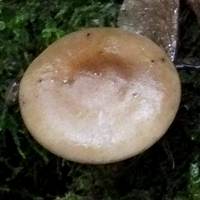 |
CapThe very variable caps are initially convex with a incurved margin, eventually flattening or becoming shallowly depressed with an umbo; the surface is smooth; slightly greasy; mid grey-brown to dark grey-brown when moist, turning paler in dry weather; 3.5 to 7cm across when fully expanded. |
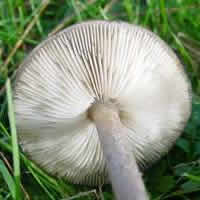 |
GillsSinuate; white, turning creamy-grey with age. StemThe stem is generally much longer than the cap diameter - often by as much as a factor of two. 4 to 9cm long and 0.5 to 1cm diameter; base slightly swollen; white, covered in pale brownish vertical fibrils; there is no stem ring. |
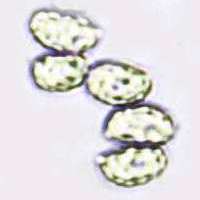 |
SporesEllipsoidal, densely warty, 7-8 x 4-6μm; amyloid. Spore printVery pale cream. |
Odour/taste |
Not distinctive. |
Habitat & Ecological role |
On soil in permanent pastures, lawns and parks; and sometimes among leaf litter in broadleaf woodland. |
Season |
July to November in Britain and Ireland. |
Similar species |
The Common Cavalier Melanoleuca polioleuca is macroscopically indistinguishable with certainty from Melanoleuca melaleuca, but it can be separated by microscopic examination of the spores, cystidia etc. Its spores are more elongated (they have a larger ratio of major to minor diameter, which in mycologists refer to as having a lower Q factor) and it has pointed fusiform gill-edge cystidia, which are absent in Melanoleuca melaleuca. More than thirty species in the Melanoleuca genus are recorded from Britain and Ireland, and most have brownish caps and white gills; separating them is a task for specialists. (Many of them are these so-called 'cavaliers' are rare finds.). |
Culinary Notes
Some of the 'cavaliers' are reported to be edible but nothing special; however, as these kinds of mushrooms are notoriously difficult to identify I recommend that they should not be collected for food.
Reference Sources
Fascinated by Fungi, 2nd Edition, Pat O'Reilly 2016, reprinted by Coch-y-bonddu Books in 2022.
Dictionary of the Fungi; Paul M. Kirk, Paul F. Cannon, David W. Minter and J. A. Stalpers; CABI, 2008
Taxonomic history and synonym information on these pages is drawn from many sources but in particular from the British Mycological Society's GB Checklist of Fungi.
Fascinated by Fungi. Back by popular demand, Pat O'Reilly's best-selling 450-page hardback book is available now. The latest second edition was republished with a sparkling new cover design in September 2022 by Coch-y-Bonddu Books. Full details and copies are available from the publisher's online bookshop...
